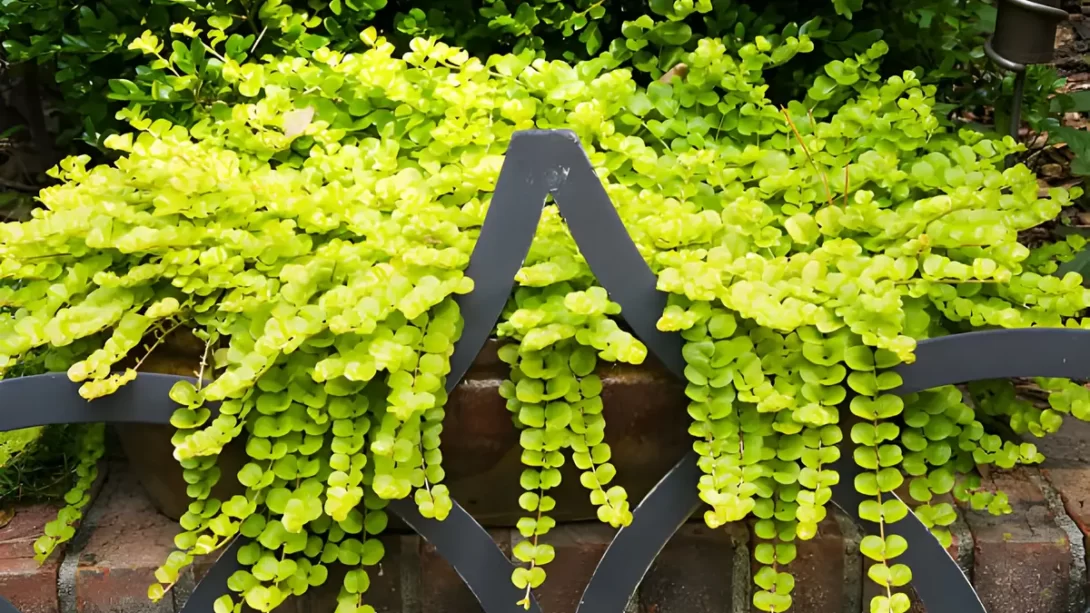Creeping Jenny, scientifically known as Lysimachia nummularia, is a fast-growing, perennial ground cover known for its vibrant green or golden leaves. This plant is often prized for its ability to quickly fill in garden spaces and its use in containers and hanging baskets. However, there is growing concern about its invasive nature in certain regions, which is an important consideration for gardeners and landscape designers.
Characteristics of Creeping Jenny
Creeping Jenny is characterized by its round, coin-shaped leaves and trailing stems that can spread vigorously over the ground. It typically grows about 2 inches tall but can spread up to 2 feet or more. It thrives in a variety of conditions, from full sun to partial shade, and prefers moist, well-drained soils. This adaptability, combined with its hardiness in USDA zones 3 through 9, makes it a versatile plant in many garden settings.
Creeping Jenny as an Invasive Species
A plant is considered invasive when it spreads aggressively outside its native range, outcompeting local flora and disrupting ecosystems. In certain areas, especially where natural checks and balances are absent, Creeping Jenny has been identified as an invasive species. Its rapid growth and ability to form dense mats can choke out native plants and alter habitats, posing a threat to biodiversity. The list of regions where Creeping Jenny is classified as invasive continues to grow, necessitating awareness and responsible gardening practices.
Factors Contributing to Its Invasive Nature
The invasive potential of Creeping Jenny largely stems from its vigorous growth and spreading capabilities. This plant can quickly cover large areas with its dense mat of foliage, outcompeting and displacing native flora. Its ability to thrive in a wide range of environmental conditions, from wet to dry soils and in both sun and shade, further contributes to its invasive behavior.
Creeping Jenny’s aggressive spread is not only a concern for natural ecosystems but also for managed landscapes. In gardens, it can overtake other plants and become difficult to control. Its competitiveness is often more pronounced in areas where it has no natural predators or diseases to keep its growth in check.
Management and Control of Creeping Jenny
Controlling the spread of Creeping Jenny is crucial, especially in areas where it is considered invasive. Gardeners should regularly monitor and manage its growth to prevent it from encroaching on other plants or escaping into natural areas. Effective control methods include manual removal, ensuring complete removal of the root system to prevent regrowth, and careful use of herbicides as a last resort.
It’s also important to be aware of legal implications. In some regions, planting Creeping Jenny is restricted or prohibited due to its invasive status. Gardeners should check local regulations before planting and consider alternative, non-invasive species.
Alternative Plants to Consider
For gardeners looking to avoid the invasiveness of Creeping Jenny, there are several non-invasive alternatives that can provide similar aesthetic appeal. Consider plants like Ajuga reptans, also known as bugleweed, which offers lush, ground-covering foliage and attractive flowers. Another option is the native golden groundsel (Packera aurea), which can thrive in similar conditions as Creeping Jenny and adds a splash of color with its bright yellow blooms.
Incorporating native plants into your garden is not only environmentally responsible but also beneficial for local wildlife, as these plants often provide essential habitat and food sources. Native alternatives tend to be better adapted to local conditions and require less maintenance once established.
Conclusion
Creeping Jenny’s status as an invasive species in certain regions highlights the need for responsible plant selection and gardening practices. While it can be a charming addition to gardens and landscapes, its potential to harm local ecosystems cannot be overlooked. By opting for alternative plants and actively managing Creeping Jenny’s growth if already present in your garden, you can contribute to preserving biodiversity and maintaining ecological balance.
Remember, the beauty of a garden lies not just in its appearance but also in its harmony with the surrounding environment. As gardeners, we have the opportunity and responsibility to make choices that support this harmony, ensuring our gardens are not only beautiful but also environmentally conscious.




